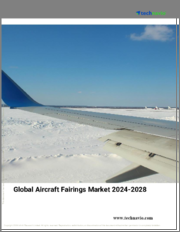
|
시장보고서
상품코드
1290895
항공기 페어링 시장 : 현황 분석 및 예측(2022-2028)Aircraft Fairing Market: Current Analysis and Forecast (2022-2028) |
||||||
항공기 페어링 시장은 항력을 줄이고 연료 효율을 개선하기 위해 항공기에 설치하는 공기역학 구조물 시장을 말합니다. 이러한 구조물은 항공기 외관을 간소화하고 매끄러운 표면을 만들어 난기류로 인한 항력을 줄이고 전반적인 성능을 개선하도록 설계되었습니다. 항공기 페어링 시장의 주요 동인 중 하나는 연료 효율이 높은 항공기에 대한 수요 증가입니다. 항공사는 연료 소비와 탄소 배출을 줄이기 위해 노력하면서 목표 달성에 도움이 될 수 있는 보다 효율적인 항공기 디자인을 찾고 있습니다. 항공기 페어링은 항력을 줄이고 공기 역학을 개선하여 연료 소비를 줄이는 데 도움이 되므로 이와 관련하여 중요한 역할을 합니다.
재료에 따라 시장은 복합재, 금속 및 기타로 분류되며, 2021년 항공기 페어링 시장에서 복합재 부문이 높은 점유율을 차지할 것으로 예상되며, 이는 몇 가지 촉진요인에 기인하는 것으로 보입니다. 첫째, 복합재료는 알루미늄과 같은 기존 재료에 비해 경량화, 고강도, 부식 및 피로에 대한 우수한 내성 등 여러 가지 장점을 가지고 있습니다. 따라서 경량화와 공기역학적 특성 개선이 연비 향상과 운영비 절감의 핵심 요소인 항공기 페어링에 사용하기에 적합합니다. 항공기 페어링 시장에서 복합재 분야의 또 다른 촉진요인은 보다 효율적이고 친환경적인 항공기 설계에 대한 수요 증가입니다.
용도별로는 동체, 랜딩 기어, 날개, 제어면, 엔진으로 구분됩니다. 동체 부문은 몇 가지 촉진요인으로 인해 항공기 페어링 시장에서 큰 비중을 차지하고 있습니다. 첫째, 동체는 항공기의 가장 크고 중요한 구성 요소 중 하나이며, 항공기의 안전과 성능을 보장하는 데 중요한 역할을 합니다. 따라서 공기 저항을 최소화하고 공기역학을 향상시키는 방식으로 동체를 안정적으로 설계 및 제작하는 것이 필수적이며, 여기서 항공기 페어링이 활약하게 됩니다. 항공기 페어링 시장에서 기체 부문의 또 다른 촉진요인은 연비가 좋은 항공기에 대한 수요 증가입니다.
최종 용도별로 보면, 시장은 상업용, 군용, 일반 항공용으로 구분됩니다. 상업용 부문은 몇 가지 요인으로 인해 항공기 페어링 시장에서 압도적인 점유율을 차지하고 있습니다. 첫째, 민간 항공사는 세계 항공 운송량의 상당 부분을 차지하며 대규모 항공기를 운영하고 있습니다. 이들 항공사는 효율성을 개선하고 운영 비용을 절감할 수 있는 방법을 지속적으로 모색하고 있으며, 그 결과 연비가 좋은 항공기에 대한 수요가 증가하고 있습니다. 항공기 페어링 시장의 상업적 부문의 또 다른 촉진요인은 세계 항공 수요 증가입니다. 세계 인구 증가와 소득수준의 향상으로 항공 여객 수송량은 특히 신흥국을 중심으로 급증하고 있습니다. 이에 따라 항공사가 주문하는 항공기 수가 크게 증가하여 항공기 페어링 시장의 성장을 가속하고 있습니다.
항공기 페어링 산업 시장 서론에 대한 이해를 돕기 위해 북미(미국, 캐나다 및 북미의 나머지 지역), 유럽(독일, 영국, 이탈리아, 프랑스, 유럽의 나머지 지역), 아시아 태평양(중국, 일본, 인도 및 아시아 태평양의 나머지 지역), 기타 국가와 같은 전 세계 국가에서의 입지를 기반으로 시장을 분석합니다. 북미가 항공기 페어링 시장에서 압도적인 점유율을 차지하고 있는 것은 몇 가지 촉진요인이 있기 때문입니다. 첫째, 북미에는 보잉, 에어버스 등 세계 유수의 항공기 제조업체들이 있습니다. 이들 기업은 이 지역에서 큰 영향력을 행사하고 있으며, 새로운 항공기 모델을 지속적으로 개발 및 생산함으로써 항공기 페어링 수요를 주도하고 있습니다. 북미 항공기 페어링 시장의 또 다른 촉진요인은 저연비 항공기에 대한 수요 증가입니다. 연료 가격 상승과 기후 변화에 대한 우려로 인해 북미 항공사들은 연료 소비와 탄소 배출량을 줄이는 데 도움이 되는 보다 효율적인 항공기 설계를 요구하고 있습니다. 매년 항공기를 이용하는 사람이 늘어나면서 항공사와 승객의 요구를 충족시킬 수 있는 새롭고 개선된 항공기 설계가 지속적으로 요구되고 있습니다. 이러한 수요는 제조업체들이 보다 효율적이고 합리적인 항공기 설계를 개발하기 위해 노력하면서 항공기 페어링 시장의 성장에 박차를 가하고 있습니다. 예를 들어, 2020년 보잉사는 항공기 페어링의 무게를 크게 줄이고 성능을 향상시킬 수 있는 새로운 복합재료를 성공적으로 테스트했다고 발표했습니다.
목차
제1장 시장 서론
- 시장의 정의
- 주요 목적
- 이해관계자
- 제한 사항
제2장 조사 방법 또는 전제조건
- 조사 과정
- 조사 방법
- 응답자 개요
제3장 시장 요약
제4장 주요 요약
제5장 COVID-19가 세계 항공기 페어링 시장에 미치는 영향
제6장 세계의 항공기 페어링 시장 매출, 2020-2028년
제7장 시장 인사이트 : 소재별
- 복합
- 금속
- 기타
제8장 시장 인사이트 : 최종 용도별
- 상업
- 군
- 일반항공
제9장 시장 인사이트 : 용도별
- 기체
- 착륙장치
- 날개
- 제어 표면
- 엔진
제10장 시장 인사이트 : 지역별
- 북미
- 미국
- 캐나다
- 기타 북미
- 유럽
- 독일
- 영국
- 프랑스
- 이탈리아
- 기타 유럽
- 아시아태평양
- 중국
- 일본
- 인도
- 아시아태평양(APAC) 기타 국가
- 세계 기타 지역
제11장 항공기 페어링 시장 역학
- 시장 성장 촉진요인
- 시장이 해결해야 할 과제
- 영향 분석
제12장 항공기 페어링 시장 기회
제13장 항공기 페어링 시장 동향
제14장 수요측과 공급측 분석
- 수요측 분석
- 공급측 분석
제15장 밸류체인 분석
제16장 가격 분석
제17장 전략적 인사이트
제18장 경쟁 시나리오
- 경쟁 구도
- Porter의 Five Forces 분석
제19장 기업 개요
- ShinMaywa Industries, Ltd.
- Strata Manufacturing PJSC.
- Malibu Aerospace LLC.
- FACC
- Daher
- The NORDAM Group LLC
- Airbus
- Boeing
- Avcorp Industries Inc.
- Barnes Group
제20장 면책사항
LSH 23.07.25The aircraft fairing market refers to the market for aerodynamic structures installed on an aircraft to reduce drag and improve fuel efficiency. These structures are designed to streamline the aircraft's exterior and create a smooth surface, reducing the drag caused by turbulence and improving its overall performance. One of the primary drivers of the aircraft fairing market is the increasing demand for fuel-efficient aircraft. As airlines look to reduce their fuel consumption and carbon emissions, they are seeking more efficient aircraft designs that can help them achieve their goals. Aircraft fairings play a critical role in this regard, as they help reduce drag and improve aerodynamics, leading to lower fuel consumption.
The aircraft fairing market is expected to grow at a strong CAGR of %9 during the forecast period owing to the growing air passenger traffic worldwide. With more people traveling by air each year, there is a constant demand for new aircraft that can meet the needs of airlines and passengers alike. This demand is fueling the growth of the aircraft fairing market, as manufacturers strive to develop more efficient and streamlined aircraft designs. For instance, in 2020, Boeing announced that it had successfully tested a new composite material for aircraft fairings that could offer significant weight savings and improved performance.
Based on material, the market is segmented into composite, metal, and others. The composite segment held a significant share of the aircraft fairing market in 2021, and this can be attributed to several drivers. Firstly, composite materials offer several advantages over traditional materials such as aluminum, including lower weight, higher strength, and better resistance to corrosion and fatigue. This makes them ideal for use in aircraft fairings, where reducing weight and improving aerodynamics are critical factors in enhancing fuel efficiency and reducing operating costs. Another driver of the composite segment in the aircraft fairing market is the increasing demand for more efficient and environmentally friendly aircraft designs.
By application, the market is segmented into the fuselage, landing gear, wings, control surfaces, and engine. The fuselage segment holds a significant share of the aircraft fairing market due to several drivers. Firstly, the fuselage is one of the largest and most important components of an aircraft, and it plays a critical role in ensuring the safety and performance of the aircraft. Therefore, it is essential to ensure that the fuselage is designed and constructed in a way that minimizes drag and improves aerodynamics, which is where aircraft fairings come into play. Another driver of the fuselage segment in the aircraft fairing market is the increasing demand for more fuel-efficient aircraft.
On the basis of end-users, the market is segmented into commercial, military, and general aviation. The commercial segment holds a dominating share of the aircraft fairing market due to several drivers. Firstly, commercial airlines account for a significant proportion of global air traffic and operate a large fleet of aircraft. These airlines are constantly looking for ways to improve their efficiency and reduce their operating costs, which has led to a growing demand for more fuel-efficient aircraft. Another driver of the commercial segment in the aircraft fairing market is the increasing demand for air travel worldwide. The growing global population and rising income levels have led to a surge in air passenger traffic, particularly in emerging economies. This has led to a significant increase in the number of aircraft being ordered by airlines, which in turn is driving the growth of the aircraft fairing market.
For a better understanding of the market adoption of the aircraft fairing industry, the market is analyzed based on its worldwide presence in the countries such as North America (U.S., Canada, and the Rest of North America), Europe (Germany, UK, Italy, France, Rest of Europe), Asia-Pacific (China, Japan, India and Rest of Asia-Pacific), Rest of World. North America region holds a dominating share in the aircraft fairing market due to several drivers. Firstly, North America is home to some of the world's leading aircraft manufacturers, such as Boeing and Airbus. These companies have a significant presence in the region and are driving the demand for aircraft fairings through their ongoing development and production of new aircraft models. Another driver of the aircraft fairing market in North America is the increasing demand for fuel-efficient aircraft. With rising fuel prices and concerns over climate change, airlines in North America are seeking more efficient aircraft designs that can help them reduce fuel consumption and carbon emissions. With more people traveling by air each year, there is a constant need for new and improved aircraft designs that can meet the needs of airlines and passengers alike. This demand is fueling the growth of the aircraft fairing market, as manufacturers strive to develop more efficient and streamlined aircraft designs. For example, in 2020, Boeing announced that it had successfully tested a new composite material for aircraft fairings that could offer significant weight savings and improved performance.
Some of the major players operating in the market include: ShinMaywa Industries, Ltd., Strata Manufacturing PJSC., Malibu Aerospace LLC. , FACC, Daher, The NORDAM Group LLC, Airbus, Boeing, Avcorp Industries Inc., and Barnes Group
TABLE OF CONTENTS
1 MARKET INTRODUCTION
- 1.1. Market Definitions
- 1.2. Main Objective
- 1.3. Stakeholders
- 1.4. Limitation
2 RESEARCH METHODOLOGY OR ASSUMPTION
- 2.1. Research Process of the Aircraft Fairing Market
- 2.2. Research Methodology of the Aircraft Fairing Market
- 2.3. Respondent Profile
3 MARKET SYNOPSIS
4 EXECUTIVE SUMMARY
5 GLOBAL AIRCRAFT FAIRING MARKET COVID-19 IMPACT
6 GLOBAL AIRCRAFT FAIRING MARKET REVENUE, 2020-2028F
7 MARKET INSIGHTS BY MATERIAL
- 7.1. Composite
- 7.2. Metal
- 7.3. Others
8 MARKET INSIGHTS BY END-USERS
- 8.1. Commercial
- 8.2. Military
- 8.3. General Aviation
9 MARKET INSIGHTS BY APPLICATION
- 9.1. Fuselage
- 9.2. Landing Gear
- 9.3. Wings
- 9.4. Control Surfaces
- 9.5. Engine
10 MARKET INSIGHTS BY REGION
- 10.1. North America
- 10.1.1. U.S.
- 10.1.2. Canada
- 10.1.3. Rest of North America
- 10.2. Europe
- 10.2.1. Germany
- 10.2.2. UK
- 10.2.3. France
- 10.2.4. Italy
- 10.2.5. Rest of Europe
- 10.3. Asia-Pacific
- 10.3.1. China
- 10.3.2. Japan
- 10.3.3. India
- 10.3.4. Rest of APAC
- 10.4. Rest of the World
11 AIRCRAFT FAIRING MARKET DYNAMICS
- 11.1. Market Drivers
- 11.2. Market Challenges
- 11.3. Impact Analysis
12 AIRCRAFT FAIRING MARKET OPPORTUNITIES
13 AIRCRAFT FAIRING MARKET TRENDS
14 DEMAND AND SUPPLY-SIDE ANALYSIS
- 14.1. Demand Side Analysis
- 14.2. Supply Side Analysis
15 VALUE CHAIN ANALYSIS
16 PRICING ANALYSIS
17 STRATEGIC INSIGHTS
18 COMPETITIVE SCENARIO
- 18.1. Competitive Landscape
- 18.1.1. Porters Fiver Forces Analysis
19 COMPANY PROFILED
- 19.1. ShinMaywa Industries, Ltd.
- 19.2. Strata Manufacturing PJSC.
- 19.3. Malibu Aerospace LLC.
- 19.4. FACC
- 19.5. Daher
- 19.6. The NORDAM Group LLC
- 19.7. Airbus
- 19.8. Boeing
- 19.9. Avcorp Industries Inc.
- 19.10. Barnes Group














